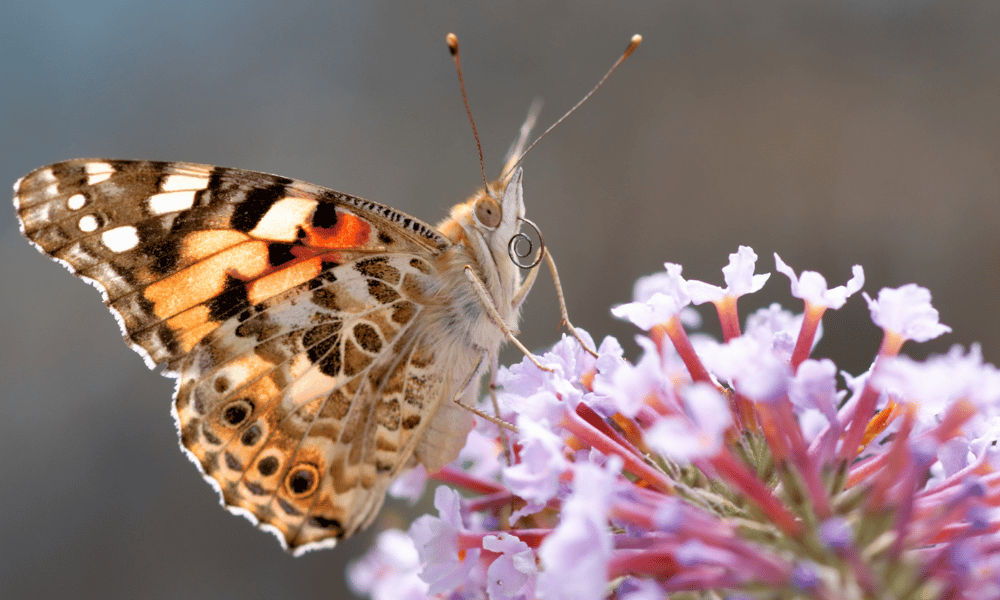Butterflies have one of the most unique anatomies among all insects. Their eating habits and methods have always been quite unusual. The mouth plays a significant role in eating for most insects. So, the question here is, do butterflies have mouths?
Butterflies do have mouths. However, their mouths are very different and are unlike a typical mouth with a jaw. Instead, butterflies have a long tube-shaped organ known as the proboscis.
The proboscis performs all the basic functions of a mouth. Since butterflies do not consume solid food, it helps butterflies in sucking nectar and other elements to fulfil their nutritional needs.
It is essentially a long straw that can suck liquids and very mushy food items. Because of this mouthpiece, butterflies cannot eat hard or solid foods. This is why you’ll often see them eating rotten fruits but not fresh fruits.
Do Butterflies Have Teeth?
No, butterflies do not have teeth. Butterflies do not have bones, cementum, tooth pulp, or even dentin. They have no form of teeth nor anything that could be mistaken for teeth.
Like many insects, butterflies do have certain mouthparts. Most insects have a mandible that helps them bite and chew and stylets to suck on liquids. Butterflies, instead, have a long tongue-like organ that is rolled beneath their head most of the time. This is why they cannot bite humans.
The question that arises here is, do butterflies even need teeth? The answer is no. This is why they have never evolved to have teeth.
This is because butterflies do not consume solid foods as their primary source of nutrition. Their main source of nutrition is through sucking nectar from flowers.
Rather confusingly, after a butterfly’s egg hatches and becomes a caterpillar, it does require teeth. They lose their teeth during the metamorphosis stage when they evolve into adults.
Oddly, it’s quite common for the adult version of insects to lose mouthparts!
Want to Attract Butterflies to Your Garden?
We’ve Put Together an Ultimate Guide to Attracting Butterflies to Your Garden Including Our Top 11 Plants You NEED to Start Growing Today:
Do Butterflies Have Tongues?
No, butterflies do not have tongues as many humans and animals do. However, what they have is a proboscis which many people consider a tongue.
However, it is more like an elongated tube. Just like tongues, proboscis is also composed of taste buds. However, they can also be found on the antennae of a butterfly, and the majority of them are located on the butterfly’s feet.
This is why butterflies are also famously known as leg tasters. These taste buds are often called chemoreceptors and are connected to nerves. When a chemical comes into contact with them, the nerves get activated, sending these signals to the butterfly’s brain.
Yes, you read that right… Butterflies taste with their legs and feet!
No, butterflies do not have lips. This is because butterflies do not have a typical mouth like many animals and humans. Even if butterflies did have lips, they would be useless to them since their tube-like mouth gets curled up.

How Do Butterflies Eat?
Strictly speaking, butterflies do not ‘eat’. The majority of the items they consume are in liquid form. They drink by sucking on flowers for their sugary nectar and from mud, urine, or faeces for salty elements (you can learn more about this disgusting habit here).
Since butterflies have no use for grinding or chewing mechanisms, they have a proboscis that helps them suck.
A butterfly’s proboscis is a long tube-like organ that helps them suck from flowers. Its length ranges from 28mm to 45mm, and it helps butterflies suck nectar from all kinds of flowers regardless of length and size.
It is composed of two fibres, c-shapes, and galeae, that come together when the insect comes out from the pupa. It self-assembles with the help of saliva discharge – nice, right?
Since the proboscis helps butterflies eat, they cannot live if it is damaged or isn’t properly formed. If the proboscis isn’t developed when the butterfly is a chrysalis, they usually have a split proboscis as adults.
A split proboscis means a butterfly cannot suck any form of nutrition, and it ultimately dies.
In addition, if butterflies feel their food isn’t liquid enough, they simply use their digestive tract to excrete fluids to add moisture to their food.
When the proboscis isn’t in use, butterflies roll it underneath their head and stretch it out whenever needed.
Lastly, we know that butterflies suck on flowers when they’re looking to feed on something sweet. However, when they want something salty, they indulge in puddling, which is essentially finding muddy puddles or animal faeces and sucking up the salty elements from them.
Yes! This might be disgusting but butterflies do extract some beneficial nutrients from animal faeces and urine but also mud. Nectar is loaded with sugar so butterflies have to turn to faces for other nutrients.
Summary
So, we can say that even though a butterfly’s mouth doesn’t fit into the standard description of a mouth with lips, teeth, or even a jaw, nature has blessed them with a unique organ that fulfils all the needs that a mouth would.
This organ, or the proboscis, may look very similar to a long tongue and helps butterflies sin sucking nectar from flowers of all shapes, sizes, and lengths and even from the sand.
However, the most interesting part of a butterfly’s anatomy is that, unlike many other insects and animals, butterflies do not have their taste buds in their mouth.
You can continue to learn about butterflies and their anatomy by discovering whether or not they have eyes here.






